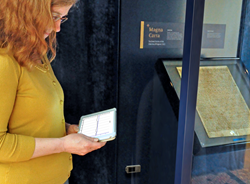
Onset’s Bluetooth Smart Data Logger Protects the Magna Carta
Onset, a world leader in data loggers for building performance monitoring, today announced that the HOBO MX1101, the company’s first data logger that measures and transmits temperature and relative humidity data wirelessly to mobile devices via Bluetooth Smart technology, is helping to protect a copy of the Magna Carta.
Originally issued by England’s King John in June 1215 to prevent civil war between the king and his barons, the Magna Carta is a world-famous symbol of justice, fairness, and human rights. Having inspired and encouraged movements for freedom and constitutional government for hundreds of years, the four remaining copies have been awarded ‘Memory of the World’ status by the United Nations Educational, Scientific, and Cultural Organization (UNESCO).
The best-surviving copy of the Magna Carta, currently on exhibition in Britain’s Salisbury Cathedral to commemorate the document’s 800-year anniversary, is stored in a glass display case along with an Onset HOBO MX1101 Bluetooth Temperature/Relative Humidity data logger.
“Preserving the text is of paramount importance,” said Emily Naish, Archivist at Salisbury Cathedral. “Excessive humidity can cause parchment to buckle as it tries to revert to its natural shape. The parchment can expand while the ink remains static, causing ink to lift from the text. As the room in which the Magna Carta is displayed has large glass windows, it is prone to these kinds of damaging fluctuations in humidity.”
Because the display case is sealed and protected by alarm systems, there was no way to constantly monitor temperature and humidity without going through the time-consuming and complicated process of switching off the alarms and accessing the case.
To address this issue, the Cathedral’s exhibition team installed the HOBO MX1101 data logger, purchased through Onset’s UK distributor, Tempcon Instrumentation Limited. The self-contained wireless data logger, which works with Onset’s free HOBOmobile™ app for logger setup and data management, enables staff to use a smart phone or tablet to access the environmental data at any time from a distance up to 100 feet, without having to open the display case – making the HOBO MX1101 the perfect choice for use in the restricted-access conditions of the Cathedral.
“The HOBO MX1101 is an ideal solution for us to protect such an important historical artifact as the Magna Carta,” said Naish. “It’s great that I can check the current conditions at a glance, and have the ability to access historical data without interfering with the exhibit.”
To learn more about the HOBO MX1101 Temperature/ Relative Humidity data logger, visithttp://www.onsetcomp.com/mx.